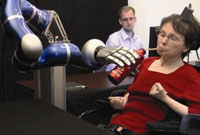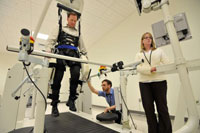
Providence VA launches neurotechnology center
VA researchers and colleagues made headlines back in May 2012 when they demonstrated that people with total paralysis could control robotic arms using only
their thoughts.
The same researchers are part of a new center of excellence dedicated last month at the Providence (R.I.) VA Medical Center.
The Center for Neurorestoration and Neurotechnology will receive $900,000 per year for five years from VA. The mission is to develop and test new
technologies to help Veterans and others with conditions affecting the brain and movement. Examples include spinal cord injury, stroke, ALS, Parkinson's
disease, and multiple sclerosis. The work will also potentially benefit those with limb loss, as well as those with mental health disorders such as
depression and posttraumatic stress disorder.
The center will join the efforts of VA, Brown University, Massachusetts General Hospital, and two other Providence-area health care providers: Butler
Hospital, and Lifespan.
Researchers at the center will cover four main areas:
-
Brain-computer interfaces—These systems allow brain signals to be picked up by electrodes and fed to a computer, which turns them into commands for devices. A leading example is
BrainGate, the system responsible for the news-making breakthrough mentioned above. The technology could enable people with paralysis to control an
assistive device. It could also help people with limb loss move a prosthetic arm just by thinking about it.
-
Prosthetic limb evaluation—Researchers will study the technology and the social and psychological issues involved in amputation and prosthetics use. Some of the work will involve
further evaluation of the DEKA arm, a high-tech prosthesis that was developed through the Defense Advanced Research Projects Agency. The arm has been
tested at several VA sites.
-
Restoration of motor function—These studies will use robots and other technology to help restore mobility and movement to those affected by stroke, multiple sclerosis, or traumatic
brain injury. One example of successful past research is a set of robots, developed at MIT and tested in a large VA clinical trial, that help move the
affected limbs of people affected by stroke, as part of therapy. The researchers will also used motion sensors and advanced brain imaging to pinpoint the
brain mechanisms that control movement.
-
Restoration of affective and cognitive function—Investigators will explore therapies that aim to fix faulty brain and neural circuits responsible for mood and cognitive problems such as depression,
obsessive-compulsive disorder, and posttraumatic stress disorder. The researchers will also address chronic pain. One of the approaches to be studied is a
new form of transcranial magnetic stimulation. In TMS, a magnetic coil is applied to the brain to enhance function. The therapy is approved to treat major
depression and is being investigated for possible use in other brain disorders.



